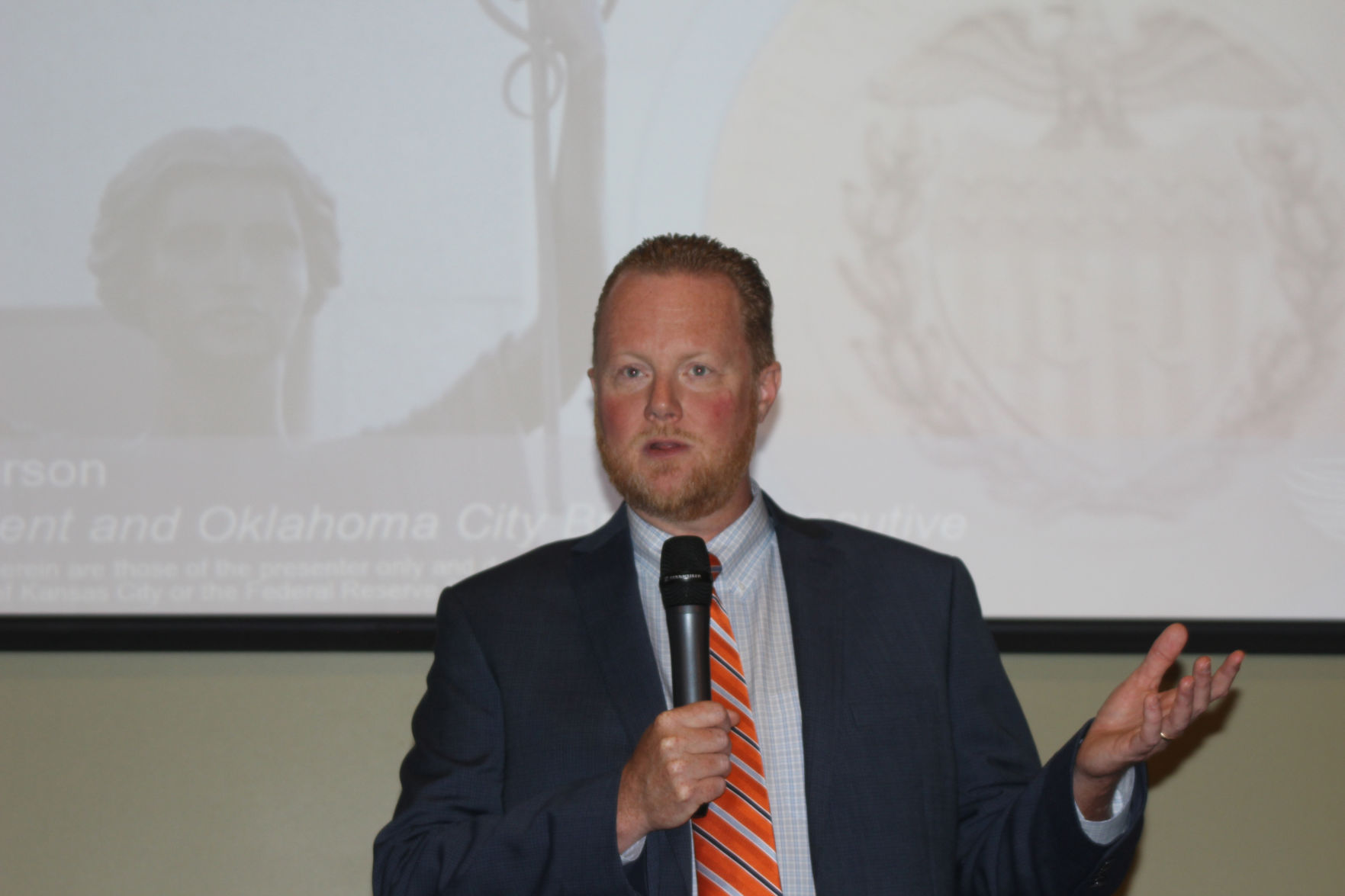The regional economic forecast, from the standpoint of an executive with the Federal Reserve Bank of Kansas City, Missouri, is going to be hard to project because of unpredictability in the trade picture.
Chad Wilkerson, vice president and Oklahoma City branch executive with the KC Fed, provided his insight during an Aug. 9 forum at Guymon Petro Bar and Grill in Dodge City, Kansas. Wilkerson is responsible for briefing Esther L. George, the president of the KC Fed, on economic activity in the Tenth Federal Reserve District. George is a member of the Federal Open Market Committee that determines Fed monetary policy. During his luncheon Wilkerson provided an overview of national, regional and local economies, along with specific indicators for the Dodge City, Kansas, area.
National overview
The Gross Domestic Product in the second quarter had 2.1% growth, which has been the slowest growth rate in the past 18 months.
“Most of this was anticipated,” the Fed executive said. “Not all parts of the economy are growing. Consumer spending is strong. Business investment is soft. Exports have fell.”
The tariffs policy implemented by President Donald Trump, in particular toward China, has caused “a direct hit on exports.”
There has been additional news that was recently released that showed the overall labor market continues to be strong although the manufacturing sector is slowing but the service sector has some brighter numbers.
Dual mandate
The Federal Reserve’s role in monetary policy has a dual mandate from Congress—maximum employment and price stability, Wilkerson said.
Wilkerson said input gathered during tours is important because “mostly (Fed) data comes out with a lag.”
The national unemployment rate is 3.7% and some might say represents full employment as the traditional target by the Fed has always been at 4%. Wilkerson noted that defining the true unemployment rate does not measure Americans who have been jobless for an extended time and have given up on finding jobs or those who may have stopped working for personal reasons and recently decided to re-enter the job force. He said in either case those numbers can be significant and difficult to quantify.
It’s other mandate, controlling inflation, has a long-term goal of 2%. With current lower energy costs that has kept the rate below that benchmark at times.
Fed lowers funds rate
The FOMC recently used the unemployment rate and inflation figures as a way to lower the federal funds rate to 2 to 2.25%, which could signal a lower interest rate. Wilkerson’s boss, George, disagreed in her dissenting view noting that by maintaining the previous committee’s rate of 2.25 to 2.5%, the FOMC could lower the funds if it became necessary if trade policy uncertainty worsened and weaker global activity occurred.
“The markets are expecting future rate cuts,” Wilkerson said is a likely outcome of the FOMC’s decision. “It’s at an influx at this moment.”
Regional level
Regionally, since 2014, Kansas’ job growth has been slower than the rest of the country, he said. In 2018 the job growth was a full percentage point behind the country and that trend is similar in southwest Kansas. The job growth in southwest Kansas is measured primarily in the energy, agriculture, manufacturing and government sectors.
Wilkerson believes that “labor availability” is one of the factors for slower growth as there are fewer qualified people to take jobs. In Ford County, Kansas, the unemployment rate is 2.3%, which is well below the 3.7% U.S. rate.
In the energy sector, which is important to Kansas and Oklahoma economies, there have been job cuts as oil exploration is occurring in other United States fields. Wilkerson noted that those regions have led a charge in which U.S. oil and gas production doubled from 2012 to 2017. In regions that have not shared in that boom, credit has been tightened to firms of all sizes that serve the industry.
Manufacturing and agriculture have also seen similar trends as Trump’s tariffs policies have impacted bottom lines.
Ag incomes have dramatically fallen since the peak of five years ago, although a source of good news is that for the first time in five years farm income is projected to be flat instead of continuing its slide, Wilkerson said. That should help producers and their bankers both. But the uncertainty of the trade war has to be monitored by the Fed, too.
“We are keeping a close eye,” he said.
Land values have stayed stable and that has helped producers and lenders. Wilkerson said the recent headlines that China may stop importing U.S. soybeans, hogs and dairy products has not hit the western Kansas economy as significantly as it has in the middle part of the country because the production of those food items are elsewhere in the country.
He also gave a brief outline of the history of the Fed and while it is best known for setting interest rates, it also in in charge of regulating banks and financial services. Wilkerson noted the Fed recently announced it will develop a real-time system that will provide instantaneous access for monetary transfers. There’s always been a clearing time but Wilkerson said with today’s technology there are now ways to do that and make it more transparent.
Dave Bergmeier can be reached at 620-227-1822 or [email protected].




